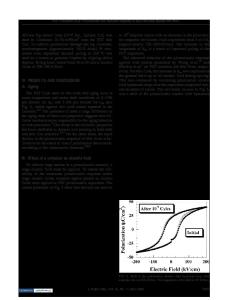Synthesis and properties of lead zirconate titanate thin films via metalorganic chemical vapor deposition
- PDF / 472,897 Bytes
- 7 Pages / 612 x 792 pts (letter) Page_size
- 109 Downloads / 358 Views
Ferroelectric PZT thin films were deposited on Pt and SrRuO3 substrates in a cold-wall reactor, using the Pb(C2H5)4/Zr(OBu)4/Ti(OPri)4/O2 reaction system. In comparison with Pt substrate, the growth rate of lead zirconate titanate (PZT) thin film was higher on SrRuO3. Lead content of the thin film deposited on either substrate at low temperatures (723–863 K) was much more temperature dependent than the other two metal contents. The strong temperature dependence originated from the high activation energy in the initial decomposition of Pb(C2H5)4 vapor, which was 54 kcal/mol. The surface reaction constant of lead precursor had much lower temperature dependence. The activation energy of surface reaction for PbO, estimated from deposition in a mini-chamber, was 6 kcal/mol on Pt and 9 kcal/mol on the SrRuO3 substrate. Therefore, the incorporation path of component oxide PbO, whose apparent activation energy was 31 kcal/mol on Pt and 29 kcal/mol on SrRuO3, essentially involved considerable gas-phase reaction. The PZT (50/50) thin film on SrRuO3 bottom electrode possessed a lower coercive field and a smaller remnant polarization than that on Pt. The PZT capacitor on SrRuO3 was also less vulnerable to polarization fatigue.
I. INTRODUCTION
Potential applications in ferroelectric random access memory have inspired intensive research on preparation and properties of ferroelectric thin films, in which Pb(Zr,Ti)O3 (PZT) and SrBi2Ta2O9 are two prominent compositions.1 PZT thin films bear superior properties, such as high switching speed, low operating voltage, and better endurance. However, PZT capacitors on the commonly used Pt electrode suffer from significant polarization fatigue problems, which could be more severe as devices are pushed to their limits of operation.2–4 Conductive oxide electrodes, such as RuO2, SrRuO3, (La0.5Sr0.5)CoO3, LaNiO3, YBa2Cu3O7, have been reported to alleviate this fatigue problem,5–12 but the leakage current densities of these capacitors are higher than those on metallic electrodes. Reducing the polarization fatigue without increasing leakage current has been achieved in the capacitors using the hybride electrode, such as Pt/SrRuO3,13 and SrRuO3 /Ru/Pt/Ti.14 Metalorganic chemical vapor deposition (MOCVD) has been recognized as the thin film technology suitable for industrial fabrications. Its major advantages include device-quality crystalline film, large-area deposition, and conformal layers on the microstructures of high aspect a)
http://journals.cambridge.org
II. EXPERIMENTAL
Pb(Zr,Ti)O3 thin films were deposited on SrRuO3/Si(001) and Pt/Ti/SiO2/Si(001) substrates in a barrel-type coldwall reactor under oxidizing atmosphere, using tetraethyl
Address all correspondence to this author. e-mail: [email protected]
1536
ratios. One basic issue in depositing a thin film of three or four elements is its composition control.15 The Ti-rich composition of PZT displays a more rectangular hysteresis loop, hence, more switchable polarization.16 Insufficient PbO in the composition or loss of PbO du
Data Loading...











